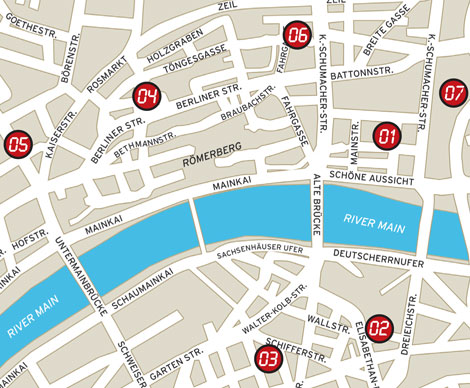The banking capital of Europe is not everyone’s idea of a tourist destination… but that means smaller crowds in the good bits. Andrew Eames reports.

1. The Romerberg
Many business visitors never see it, but the tourist heart of Frankfurt is the Romerberg, a reconstructed square down by the river where the kaisers were crowned in medieval times. Here stands the gabled, Gothic-fronted City Hall, where the coronation banquets were held. With fountains, statues and floral displays, it all looks tremendously picture-postcard, particularly the square’s Ostzeile – “Eastern Row” – of beamed and galleried merchants’ houses. But these buildings are practically all reconstructions, after almost all of them were destroyed in the Second World War – from the front they’re all seasoned timber and lime wash, but wander around the back and they’re concrete and steel. Nevertheless, the Romerberg provides a bit of historical soul for a city that can seem a bit like a business park at times.
2. Goethe Haus
This may be a bit heavy for the average tourist, but if you are a serial visitor to Frankfurt and an interested student of the German character, then you have to pay homage to Johann Wolfgang von Goethe, Germany’s Shakespeare, who was born just around the corner from the Romerberg, in 1749. His tragic play Faust is incredibly dense reading, but does contain many insights into the German psyche. The house in which he grew up has been carefully restored (again, it is mainly a post-war reproduction) but there are still some original artefacts such as a piano, cooking implements, an astronomical clock and his father’s collection of art and books. Open Mon-Sat 10am-6pm and Sunday 10am-5.30pm. Grosser Hirschgraben, tel +49 69 138 800, goethehaus-frankfurt.de.
3. Main Tower
It’s only a short walk north from the Romerberg to the Zeil, Germany’s most profitable shopping promenade, which houses branches of all the big-name stores. Head west, past the restaurant-lined Fressgass (“Glutton Alley”) to Goethestrasse, where all the international designers hang out. Turn left at the grand Alte Oper (“Old Opera”) and head down to the 200-metre high Main Tower, which opened in 2000, and has become one of the city’s icons. There’s a spectacular view of the “Mainhattan” skyline and of the old city centre from an outdoor viewing platform on the 54th floor, as well as a glass-walled restaurant and a television studio one storey down, which sometimes needs live audiences for popular shows. The viewing platform is open Sun-Thurs 10am-9pm, and Fri-Sat 10am-11pm. (It closes two hours earlier in winter.) Entry is €4.60. Neue Mainzer Strasse 52-58, maintower.de.
4. The River Main
Over the last couple of decades the River Main has been rediscovered as a place of leisure and recreation, with a range of innovative museums lining the promenade along the south bank. There are ways of promenading along the water, too. The Bootshaus Dreyer, on the south bank virtually underneath the iron Eiserner Steg footbridge, has a waterside café on a pontoon and a range of rowing and pedal boats for hire. It’s great fun on a sunny afternoon, although you have to be careful to stick close to the bank, because the Main is a commercial waterway and some of the shipping can be quite menacing. Alternatively, there are more traditional one-hour boat trips from the opposite bank. Open 11am-11pm. Call +49 69 621 935 or visit bootshaus-dreyer.de.
5. Museum Embankment.
Nine museums line the southern bank of the River Main, the Museumsufer. In a mixture of 19th-century structures and new-builds of striking design, they are objects of admiration in and of themselves, no matter what their speciality. Communications, sculpture, film, architecture, distant cultures and art are all celebrated here, but the most famous of the institutions is the Stadel, housing one of Germany’s finest art collections, with works by the likes of Durer, Holbein, Cranach, Rembrandt, Vermeer, Monet, Van Gogh, Cézanne, Matisse and Picasso. If you want to dip in and out of the various disciplines you can get one ticket to cover all the museums. Open Tuesday and Fri-Sun 10am-6pm, and Weds-Thurs 10am-9pm. Closed Monday. Durerstrasse 2, tel +49 69 605 098 200, staedelmuseum.de.
6. Sachsenhausen
The only district of Frankfurt that feels truly local is Sachsenhausen, south of the river. A former working-class region, it is now famous for its ebbelwoi (apple-wine) pubs, many with large open-air terraces and trestle tables groaning with regional specialities such as schweinshaxe (pork knuckles). There’s plenty of choice, although a particular favourite is the Adolf Wagner in Schweizer Strasse (apfelwein-wagner.com). There’s a great feeling of bonhomie in these places, and many have live music, but don’t be fooled by the “local” flavour – most of the customers are visitors like you and me. And that ebbelwoi is deceptively strong.
7. Money Museum
The home of the Deutsche Bundesbank is the obvious place for a money museum, so once you’ve finished making it, why not go to study what this building likes to call “payment media”? A short metro ride to the west of town, the museum is not just a row of coins in glass cases. There’s interesting stuff about the tracking down of counterfeiters, how the euro note was designed, what life would be like without money (in the imaginary land of Nonpekunia), as well as analyses of the perils of inflation/deflation. What’s more, it’s free! Open daily (except Saturday) 10am-5pm, and Wednesday 10am-9pm. (The closest metro station is Dornbusch.) Wilhelm-Epstein-Strasse 14; tel +49 69 9566 3073 or visit geldmuseum.de.








